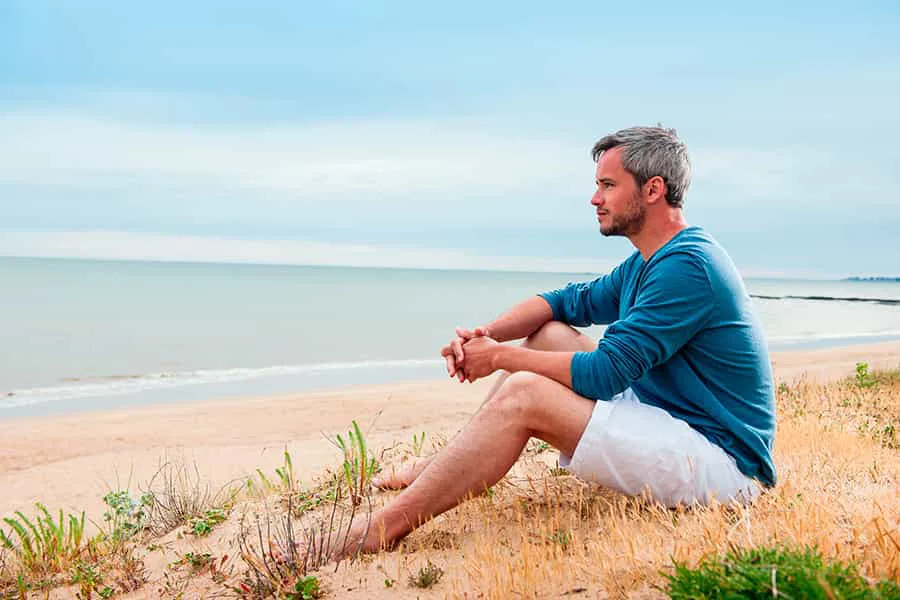Dream Journal
 Note From Dr B.
Note From Dr B.
I created the “3-7-3” philosophy as part of my commitment to holistic, evidence-based treatment that is both all-inclusive and highly effective. Patients are required to examine their progress introspectively throughout their stay at Two Dreams and spend every day working to complete the three phases of treatment via our seven dimensions of treatment. When both the patient and the staff feel that the individual has achieved the three main outcomes of recovery, mental peace, physical wellbeing, and personal productivity, they are ready to transition out of our facility.
The first few editions of the Dream Journal this year are going to focus on the first “3” of the “3-7-3” philosophy, a number that represents the three phases of treatment at Two Dreams. The three phases are a naturally occurring progression; they are not time limited, and clients can transition in and out of them depending on several clinical factors. The third phase, and the subject of this edition of the Dream Journal, is the “Looking Out Phase.”
The Looking Out Phase, as the name suggests, is all about looking outward and meditating on a future in long-term recovery. Patients in this phase have all the tools they need from treatment and may begin making decisions about where to go and what to do after Two Dreams. They make a plan to continue building on the gains they made while in primary treatment, including working on managing cravings, managing relationships, and reintegrating into their next living environment. This phase provides a supportive environment in which to practice newly gained skills and outlooks. Our professional staff continues to guide clients by encouraging them to utilize their strengths and the positive attributes revealed to them during their stay at Two Dreams.
Please call us today at 504-510-2331 for more information about the Looking Out Phase or our treatment program in general. We look forward to speaking with you.
Sincerely,
Dr. B
Theme Analysis As Relates to the 12-Steps
The Looking Out Phase
In preparing to leave Two Dreams and begin a life of sustained recovery, the last three steps of the 12 steps of Alcoholics Anonymous become most pertinent. As step 10 suggests, patients continue to take a personal, searching, and fearless moral inventory of self and practice promptly admitting fault and/or wrongdoing. Staff members guide patients through this step in process groups so that individuals are able to practice in a safe, judgment-free environment. Simultaneously, as step 11 recommends, patients seek through prayer and meditation to improve conscious contact with a Higher Power. Two Dreams encourages mindfulness in every aspect of daily living and our treatment program help patients to practice this skill through daily journaling exercises, yoga classes, meditative beach walks, process groups, and more. Finally, as step 12 advocates, after experiencing a spiritual awakening as a result of their recovery patients are encouraged to carry their lessons learned to other individuals struggling with addiction and to continue practicing the 12-steps in all of their affairs.
Two Dreams endorses continuation in the 12-step program through community meetings after leaving the treatment center. Continued participation in the program increases the likelihood of sustained sobriety and reinforces communal relationships needed to succeed in recovery.
News Highlights
Technology is revolutionizing healthcare and making it easier to create a long-term plan for recovery! A prime example is telemedicine, which is making it easier for patients to check in with medical professionals even if they live in underserved areas. In the field of addiction medicine, where licensed addictionologists are few and far between, this has the potential to be a complete game-changer for patients seeking care.
To read more about telemedicine and the digital health revolution, click here: http://fortune.com/2017/04/20/digital-health-revolution/
Mindfulness Decreases Stress in College Freshmen, Could Help You Too!
Developing a plan for mindfulness in daily life is an important part of long-term recovery and the Looking Out Phase. According to Penn State researchers, it is also a good way to help students successfully transition from high school to college without become overly stressed. Students who participated in an eight-session mindfulness training program at Penn State during their freshman year showed a significant increase in life satisfaction, as well as a significant decrease in depression and anxiety and a decrease in alcohol use.
To read more, click here: https://scienceblog.com/493617/just-breathe-mindfulness-may-help-freshman-stress-less-smile/?utm_source=feedburner&utm_medium=email&utm_campaign=Feed%3A+scienceblogrssfeed+%28ScienceBlog.com%29
Looking Out Art Therapy
The Looking Out Phase as it relates to the 3 P’s
One of the most fundamental and consistent gains made in treatment is Physical Well-Being. Having progressed to the Looking Out phase, clients have achieved abstinence, a healthy sleep cycle, exercise routine, meditation practice, and have established a healthy diet. With these foundations of recovery living now in place, clients are able to create action plans on how to maintain these gains after treatment. For example, a recent client reconnected with his love of basketball while at Two Dreams. In the Looking Out phase, this client researched local basketball leagues in his home area so that when he returns from treatment, he can reap the benefits of an active lifestyle as part of his recovery.
Mental Peace is a second core outcome of treatment at Two Dreams, and in the Looking Out phase clients are putting into action the insights they have gained. A great example of this can be found in a recent client who had a strained relationship with her daughter. This relationship had been causing the client great emotional pain. This client decided in the Looking Out phase that she wanted to share recovery in a more loving way with her daughter. She created a recovery action plan that included attending open 12 Step meetings with her daughter, as well as attending weekly Al-Anon meetings together. This client has stayed in touch with Two Dreams and we are so pleased to hear that her relationship with her daughter continues to improve!
Finally, Personal Productivity is a major goal of the treatment process. In active addiction responsibilities are neglected, avoided, and we are unable to live to our full potential. When clients are engaged in the Looking Out phase of treatment, they are often surprised by how much they want; and are able to accomplish. As clients solidify short term and long term goals, their self-esteem improves as actions become more congruent with values. A recent client of ours had significant fears about being able to maintain his recovery while balancing his family and work responsibilities. With peer support and professional guidance, this client was able to build his life around recovery, as opposed to trying to fit recovery around his life. He has found that prioritizing recovery has actually provided him with the clarity and peace to be more present and efficient in his recovery based life.
Outer Banks Community Update
At Two Dreams Outer Banks, clients are given the opportunity on a daily basis to develop and become who they really are, free of all toxic substances. Two Dreams’ professional staff guides, teaches and reinforces how to manage intense cravings and how to mend damaged relationships that have been compromised by substance use.
The clients are reminded that being participant in this program, as in any program, is a learning process. It is through the “Looking Out” Phase that clients are really able to examine their past actions and behaviors and use them as an example of what did not work for them in their past and how to learn and grow from them in the future.
In this phase, an individual can even help their peers grow by relating to them when sharing, or by providing a different perspective. The clients discuss within their peer group and with their therapists individually how to build on the gains learned as they progress through treatment to ensure that they will continue down the path for long-term success.
It is in the “Looking Out” Phase that an assignment such as the “Relapse Story” and/or “Step Three” provides the client with what is needed to obtain and retain Mental Peace, Physical Well-Being and Personal Productivity, the ultimate goals.
It is becoming increasingly busier here as the weather becomes warmer and as the summer months approach. Local construction workers have been outside on a daily basis putting in sidewalks through Duck and Southern Shores to ensure the safety of all out-of-town visitors.
Chicago Update
Recently I collaborated with Dr. Andrea Barthwell, CEO and Founder of Two Dreams to produce a featured article for Counselor Magazine, a publication for addiction and behavioral health professionals. Our article “Recovery’s Historian: An Interview with William L. White, MA” was published in the March/April edition of the magazine. It explores the life experiences of famed addiction recovery historian and writer William Write and gives tribute to his successes in the field. White is stepping down as featured columnist for Counselor Magazine this year, and Barthwell is stepping into the position.
Click here to read the article: http://www.counselormagazine.com/detailpageoverride.aspx?pageid=1729&id=15032386333
NOLA Update
This month, I accompanied Dr. Andrea Barthwell, CEO and Founder of Two Dreams, to the annual conference for American Society of Addiction Medicine (ASAM) held at the Hilton Riverside Hotel in New Orleans, LA. Just a few of the distinguished speakers we were lucky enough to listen to included Vivek Murthy, MD, MBA (Surgeon General of the United States), Patrice Harris, MD, MA (Board of Trustees Chair of the American Medical Association), and Barbara Mason, PhD (Director of the Pearson Center for Alcoholism and Addiction Research at the Scripps Research Institute). We were also able to converse with some of the former ASAM presidents about the history of addiction medicine and what they predict will happen in the future, as well as other topics. Dr. Barthwell and I will be collaborating on two Counselor Magazine articles discussing the insights we gathered from our meetings.
To read more, click here: http://www.asam.org/education/live-online-cme/the-asam-annual-conference
Thank you to our content contributors
For admissions and all staff call us at: (504) 510-2331
© 2017 Two Dreams. All Rights Reserved.

 Note From Dr B.
Note From Dr B.





